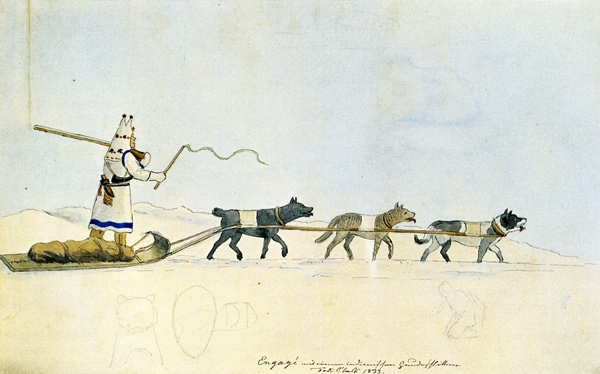Today is the coldest day recorded during their winter stay at Fort Mandan. Visiting North West Company clerk Hugh Heney gives the captains maps of the Missouri River between Fort Mandan and the Rocky Mountains. Mandan visitors report that a bison herd was scared away by some enlisted men cutting firewood.
Mr. Heney’s Valuable Information
by Yellowstone Public Radio[1]Originally aired weekdays by Yellowstone Public Radio during the Bicentennial observance of 2003-2006. Narrated by Hal Hansen. Scripts by Whit Hansen and Ed Jacobson. Produced by Leni Holliman. © … Continue reading
Dog Sled Near Fort Clark
by Prince Maximilian of Wied
Watercolor with pencil on paper: Engagé mit einem indianischen Hundeschlitten bei Fort Clark by Maximilian zu Wied-Neuwied from his travel to the United States 1832-1834, painted 1833 on the upper Missouri near Fort Clark. Joslyn Art Museum, Omaha NE. Gift of the Enron Art Foundation.
Hugh Heney Visits
We found Mr. Henny a verry intelligent man from whome we obtained Some Scetches of the Countrey between the Mississippi & Missouri, and Some Sketches from him, which he had obtained from the Indins. to the West of this place also the names and charecktors of the Sceoux [Sioux] &c
—William Clark
Scaring Away the Game
. . . towards evening the chiefs Son came from 1st vill. of the Mandans & Informed us that the Buffalow [buffalo] were comming in towards the River, & that their was a large Gang near the Fort So that our men Scared them back by cutting fire wood for the night.—
—John Ordway
Gass Builds a Sled
One of our Serjeants fixed a horse sled, for one of the North west traders, a number of that Company Traders being in the two Villages of the Mandan Nation. They trafficed with the natives for Furr, Peltry & Buffalo hides to a very considerable amount
—Joseph Whitehouse
43 Degrees Below Zero
about 8 oClock P M. the thermometer fell to 74° below the freesing pointe—
—William Clark
Weather Diary
Ther. at rise
Weather Wind at rise
Thert. at 4 P.M. Weather Wind at 4 P.M. River 43 below fair N 28 fair N. rise 3 in. at 8 P. M. this evening the Thertr. stood at 42 b. 0.
—Meriwether Lewis[2]To assist the reader, the editor of this web page has omitted the date column, merged the “River” columns, and spelled out some abbreviations.
Fort Mandan is a High Potential Historic Site along the Lewis and Clark National Historic Trail managed by the U.S. National Park Service. The North Dakota Department of Parks and Recreation manages a modern reconstruction and the Lewis and Clark Interpretive Center located at US Hwy 83 and ND Hwy 200A.
Knife River Indian Villages National Historic Site is a High Potential Historic Site along the Lewis and Clark National Historic Trail managed by the U.S. National Park Service. A unit of the National Park System, the site is located at 564 County Road 37, one-half mile north of Stanton, North Dakota. It has exhibits, trails, and a visitor center.
Notes
| ↑1 | Originally aired weekdays by Yellowstone Public Radio during the Bicentennial observance of 2003-2006. Narrated by Hal Hansen. Scripts by Whit Hansen and Ed Jacobson. Produced by Leni Holliman. © 2003 by Yellowstone Public Radio. |
|---|---|
| ↑2 | To assist the reader, the editor of this web page has omitted the date column, merged the “River” columns, and spelled out some abbreviations. |
Experience the Lewis and Clark Trail
The Lewis and Clark Trail Experience—our sister site at lewisandclark.travel—connects the world to people and places on the Lewis and Clark Trail.
Discover More
- The Lewis and Clark Expedition: Day by Day by Gary E. Moulton (University of Nebraska Press, 2018). The story in prose, 14 May 1804–23 September 1806.
- The Lewis and Clark Journals: An American Epic of Discovery (abridged) by Gary E. Moulton (University of Nebraska Press, 2003). Selected journal excerpts, 14 May 1804–23 September 1806.
- The Lewis and Clark Journals. by Gary E. Moulton (University of Nebraska Press, 1983–2001). The complete story in 13 volumes.




